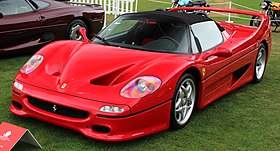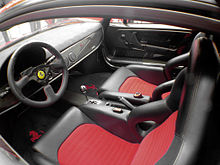Ferrari F50
| Ferrari F50 | |
|---|---|
 | |
| Overview | |
| Manufacturer | Ferrari S.p.A. |
| Production | 1995–1997 [1] 349 produced |
| Assembly | Maranello, Italy |
| Designer | Pietro Camardella[2] and Lorenzo Ramaciotti[3] at Pininfarina |
| Body and chassis | |
| Class | Sports car (S) |
| Body style | 2-door Targa top |
| Layout | Rear mid-engine, rear-wheel-drive |
| Related | Ferrari 333 SP Ferrari F50 GT |
| Powertrain | |
| Engine | 4.7L DOHC 65 degree Tipo F130B V12[4][5] |
| Power output | 382 kW (519 PS; 512 hp) |
| Transmission | 6-speed manual |
| Dimensions | |
| Wheelbase | 2,580 mm (101.6 in) |
| Length | 4,480 mm (176.4 in) |
| Width | 1,986 mm (78.2 in) |
| Height | 1,120 mm (44.1 in) |
| Curb weight | 1,400 kg (3,080 lb)[6] |
| Chronology | |
| Predecessor | Ferrari F40 |
| Successor | Ferrari Enzo |
The Ferrari F50 (Type F130) is a limited production mid-engine sports car manufactured by Italian automobile manufacturer Ferrari from 1995 until 1997. Introduced in 1995, the car is a two-door, two seat targa top. The F50 is powered by a 4.7 L naturally aspirated Tipo F130B 60-valve V12 engine that was developed from the 3.5 L V12 used in the 1990 Ferrari 641 Formula One car. The car's design is an evolution of the 1989 Ferrari Mythos concept car.[7]
A total of 349 cars were made, with the last car rolling off the production line in July 1997.[1] The F50's engine predated the car; it was used in the Ferrari 333 SP for the American IMSA GT Championship in 1994, allowing it to become eligible for the stock engine World Sports Car category.
Ferrari F50 GT
[edit]

Ferrari developed the F50 based F50 GT in collaboration with its racing partners Dallara and Michelotto to compete in GT1-class racing, following the motorsport theme of the Ferrari F40 LM. Notable changes made to the car include a fixed roof, a large rear spoiler, new front spoiler, adjustable suspension system, Speedline racing alloy wheels with racing slicks and large rear diffusers. The 4.7-litre V12 engine in the F50 GT was tuned-up to generate a power output of around 551 kW (749 PS; 739 hp) at 10,500 rpm. A test was held in 1996 which proved the car to be quicker than even the 333SP, but this went unnoticed as Ferrari cancelled the F50 GT project due to entry of purpose built racing cars in competition such as the Porsche 911 GT1 and due to lack of funding, instead focusing on Formula One after the BPR Global GT Series folded. Only 3 examples were ever built, with the three remaining tubs reportedly destroyed.[8][9]
Specifications
[edit]
General
[edit]- Manufactured in: Maranello, Italy
- Number produced: 349 (1995 until July 1997)
- Inspiration: 1990 Ferrari 641 as driven by Alain Prost[10]
Dimensions
[edit]
- Dry weight: 1,230 kg (2,712 lb) for the F50[1] and 860 kg (1,900 lb) for the F50 GT[11]
- Distribution: 42%/58% (front/rear)
- Length: 4,480 mm (176.4 in)
- Height: 1,120 mm (44.1 in)
- Width: 1,986 mm (78.2 in)
- Wheelbase: 2,581 mm (101.6 in)
- Front track: 1,621 mm (63.8 in)
- Rear track: 1,603 mm (63.1 in)
Engine
[edit]

F130 B at the Museo Ferrari 
F130 B 
Interior 
The F50 had twin 5-spoke alloy wheels. - Position: Rear mid-engine, rear-wheel-drive layout
- Configuration: Longitudinally-mounted 65° V12
- Aspiration: Naturally aspirated, with variable-length intake manifold via butterfly valve in intake manifold
- Block: nodular cast iron
- Heads/Pistons: light-alloy aluminum heads/forged Mahle pistons
- Oil sump: aluminium
- Connecting rods: forged titanium
- Crankshaft: forged steel
- Cam covers/Oil and water pump housing: magnesium sand castings
- Exhaust manifold: stainless steel
- Engine weight: 198 kg (437 lb)
- Valvetrain: 5 valves per cylinder (3 intake, 2 exhaust), 60-valves (total) DOHC per cylinder bank driven by low-noise Morse chain
- Displacement: 4,698.50 cc (4.7 L; 286.7 cu in)[1]
- Max. power: 382 kW (519 PS; 512 bhp) at 8,000 rpm
- Max. torque: 471 N⋅m (48 kg⋅m; 347 lb⋅ft) at 6,500 rpm
- Specific output.: 81.3 kW (110.5 PS; 109.0 bhp)/litre
- Weight/Power ratio: 2.69 kg/PS
- Bore X Stroke: 85 mm × 69 mm (3.35 in × 2.72 in)
- Bore:Stroke ratio: 1.23:1 (oversquare)
- Compression ratio: 11.3:1
- Redline: 8,500 rpm
- Fuel cutoff: 8,640 rpm[12]
- Fuel feed: Bosch Motronic 2.7 sequential injection and Electronic control unit (controls the fuel feed, ignition timing, and variable length intake and exhaust systems)
- Ignition system: Bosch static electronic distributor-less ignition
- Lubrication: dry sump, tank incorporated within the final drive housing, 3 scavenger pumps
- Variable intake: butterfly valve in carbon fibre intake manifold closed at low rpm, open at high rpm
- Variable exhaust: butterfly valve in upper tailpipes closed at low rpm, open at high rpm
- Fuel tank: foam filled, aeronautical-style Sekur rubber bladder, 105 L (28 US gal; 23 imp gal)
Fuel consumption
[edit]- EPA premium gasoline[13]
- Combined 8 miles per U.S. gallon (29 L/100 km; 9.6 mpg‑imp)
- City 7 miles per U.S. gallon (34 L/100 km; 8.4 mpg‑imp)
- Highway 10 miles per U.S. gallon (24 L/100 km; 12 mpg‑imp)
Transmission
[edit]- Configuration: longitudinal 6-speed manual + reverse, limited-slip differential, RWD
- Gear ratios: 2.933:1 (1st), 2.157:1 (2nd), 1.681:1 (3rd), 1.360:1 (4th), 1.107:1 (5th), 0.903:1 (6th), 2.529:1 (reverse)
- Final drive: 3.70:1
- Final drive assembly: aluminum sand casting
- Remaining gearset housing: magnesium sand casting
- Support bracing: steel
- Flywheel: steel
- Clutch: dry, twin plate
- Cooling: oil-water intercooler between gearbox lubricant and engine
Chassis
[edit]- Type: central carbon fiber tub, light-alloy suspension and engine-gearbox assembly mounting points co-polymerised to the chassis
- Materials: carbon fiber, epoxy resin, Nomex honeycomb structure core, sandwich construction
- Torsional stiffness: 34,570 N⋅m (25,500 lb⋅ft) per degree
Suspension
[edit]- Front: Rose-jointed unequal-length wishbones, push-rods, coil springs, Bilstein gas-pressurised monotube dampers, electronic adaptive damping, electronic height adjustment (40 mm max)
- Rear: Rose-jointed unequal-length wishbones, push-rods, coil springs, Bilstein gas-pressurised monotube dampers, electronic adaptive damping, mounting points on a spacer between the engine and gearbox
- Travel: 55 mm bump, 60 mm rebound
- Camber angle: -0.7 degrees front, -1.0 degrees rear
- Anti-roll bars: front and rear
- Max. roll angle: 1.5 degrees
- Electronic adaptive damping (based on steering wheel angle and velocity, the body's vertical and longitudinal acceleration, brake line pressure, and vehicle speed)
- Maximum reaction time (from minimum to maximum damping force or vice versa): 140 milliseconds (0.14 s)
- Average reaction time (from minimum to maximum damping force or vice versa): 25 to 30 milliseconds (0.025 to 0.03 s)
Steering
[edit]- Type: TRW rack and pinion, 3.3 turns lock-to-lock, unassisted
- Caster angle: 5.5 to 5.7 degrees
- Turning circle: 41 ft (12 m)
Wheels/tires/brakes
[edit]- Wheels: magnesium alloy, manufactured by Speedline
- Hubs: titanium
- Disc brake bells/suspension uprights/brake calipers: aluminum
- Upper and lower wishbones: black powder-coated steel
- Front wheels: 8.5 in × 18 in (220 mm × 460 mm)
- Front tires: 245/35ZR-18 Goodyear Eagle F1 GS Fiorano @ 35 psi (240 kPa)
- Front brakes: Brembo cross-drilled & ventilated cast iron discs, 4 piston aluminum Brembo calipers, Pagid brake pads, (without ABS)
- Rear wheels: 13 in × 18 in (330 mm × 460 mm)[12]
- Rear tires: 335/30ZR-18 Goodyear Eagle F1 GS Fiorano @ 30 psi (210 kPa)
- Rear brakes: Brembo cross-drilled & ventilated cast iron discs, 4 piston aluminum Brembo calipers, Pagid brake pads, (without ABS)
- Unsprung mass: 99 lb/121 lb (front corners/rear corners)
Colour popularity
[edit]- Rosso Corsa (red): 302
- Giallo Modena (yellow): 31
- Rosso Barchetta (dark red): 8
- Argento Nurburgring (silver): 4
- Nero Daytona (black): 4
-
Rosso Corsa
-
Giallo Modena
-
Nero Daytona
Performance
[edit]- 0–97 km/h (60 mph): 3.8 seconds[6]
- 0–160 km/h (100 mph): 8.5 seconds[14]
- 1/4 mile: 12.1 seconds at 198 km/h (123 mph)[6]
- Skidpad: 0.95 g[6]
- Braking 70–0 mph (113–0 km/h): 176 ft (54 m)[6]
- Top speed: 325 km/h (202 mph)[15]
Track tests
[edit]The F50 had the following track times:
- Tsukuba Circuit: 1:05.81[16]
- Suzuka Circuit (2000): 2:25.525[17]
- Sugo: 1:38.573[18]
- Fiorano: 1:27.00
References
[edit]- ^ a b c d "Ferrari F50 (1995) - Ferrari.com". Ferrari GT - en-EN.
- ^ "Rencontre avec Pietro Camardella & Gino Finizio" (in French). July 2006. Archived from the original on 26 September 2006. Retrieved 5 March 2008.
- ^ "Ferrari F50, the background". howstuffworks. Archived from the original on 14 December 2017. Retrieved 14 December 2017.
- ^ Derrick, Martin; Clay, Simon (2013). Million Dollar Classics: The World's Most Expensive Cars. Chartwell Books. ISBN 978-0-7858-3051-1.
- ^ "Ferrari F50 engine details". Ferraris-online.com. Retrieved 14 December 2017.
- ^ a b c d e John Phillips (January 1997). "Ferrari F50 — Why it took 13 months to get our hands on this supercar". Car and Driver. Retrieved 14 January 2012.
- ^ Jay Traugot (11 May 2013). "Ferrari F50, an evolution of the Mythos". carbuzz. Retrieved 15 December 2017.[dead link]
- ^ Ballaban, Michael (30 December 2016). "All Hail The Odd Ball Ferrari F50 GT". Jalopnik. Retrieved 21 January 2019.
- ^ "1996 Ferrari F50 GT: One of three". Classic Driver. 8 December 2012. Retrieved 21 January 2019.
- ^ "Car Collection Gallery at The Marconi - Orange County Venue". Retrieved 29 December 2016.
- ^ "Ferrari F50 GT (1996) - Ferrari.com". www.ferrari.com. Retrieved 13 August 2021.
- ^ a b "Ferrari F50" (PDF). Car and Driver. Archived from the original (PDF) on 1 October 2018.
- ^ "fueleconomy.gov". Retrieved 11 February 2016.
- ^ "C/D Test Results" (PDF).
- ^ "Ferrari F50". Ferrari. Retrieved 29 August 2023.
- ^ "Best Motoring - Platinum Series Vol. 12". YouTube.[dead YouTube link]
- ^ "Best Motoring 2000 Suzuka Super Battle". YouTube. 30 August 2015. Archived from the original on 21 December 2021.
- ^ "Best Motoring Super Car Race f50, 911 Gemballa, GT2, Murcielago, NSX R". YouTube.[dead YouTube link]
Bibliography
[edit]- Buckley, Martin; Rees, Chris (1998). World Encyclopedia of Cars. London: Anness Publishing. pp. 310–311. ISBN 9781840380835. OCLC 704533342.
Lua error in Module:Navbox at line 192: attempt to concatenate field 'argHash' (a nil value).
| Type | 1970s | 1980s | 1990s | ||||||||||||||||||||||||||||
| 0 | 1 | 2 | 3 | 4 | 5 | 6 | 7 | 8 | 9 | 0 | 1 | 2 | 3 | 4 | 5 | 6 | 7 | 8 | 9 | 0 | 1 | 2 | 3 | 4 | 5 | 6 | 7 | 8 | 9 | ||
| 8 cylinder | Mid-engine berlinetta | 308 | 308 i | 308 QV | 328 | 348 | 360 | ||||||||||||||||||||||||
| 208 | 208 Turbo | GTB/GTS Turbo | F355 | ||||||||||||||||||||||||||||
| Mid-engine 2+2 | 308 GT4 | Mondial 8 | Mondial QV | Mondial 3.2 | Mondial t | ||||||||||||||||||||||||||
| 208 GT4 | |||||||||||||||||||||||||||||||
| 12 cylinder | Boxer berlinetta | 365 GT4 BB | 512 BB | 512 BBi | Testarossa (F110) | 512TR | F512 M | ||||||||||||||||||||||||
| Grand tourer | 365 GTB/4 "Daytona" | 550 Maranello | |||||||||||||||||||||||||||||
| 2+2 grand tourer | 365 2+2 | 365 GTC/4 | 365 GT4 2+2 | 400 | 400 i | 412 | 456 | 456M | |||||||||||||||||||||||
| Flagship sports car | 288 GTO | F40 | F50 | ||||||||||||||||||||||||||||
| Legend | Sold under the Dino marque until 1976; see also Dino car timeline | ||||||||||||||||||||||||||||||
Lua error in Module:Navbox at line 604: attempt to concatenate field 'argHash' (a nil value).







